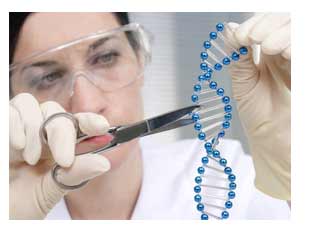 Nick Lane from New Scientest wrote an interesting article about genetically modified humans that opens as follows:
Nick Lane from New Scientest wrote an interesting article about genetically modified humans that opens as follows:
“CHILDREN with three parents might sound like monstrous chimeras, but they are among us already. In the late 1990s, an American team created the first genetically engineered humans by adding part of the egg of one woman to the egg of another, to treat infertility. When the US Food and Drug Administration got wind of the technique it was promptly banned, though related methods have been used in other countries.”
Although almost all of our DNA resides in the nucleus of our cells, there is a tiny portion of our DNA that resides separately in the mitochondria, and this mitochondrial DNA is passed down only from the mother, not from the father. It turns out that there are several seriously debilitating diseases that the mother can pass on to her child if she has defective mitochondrial genes, such as Leber’s hereditary optic neuropathy and Leigh syndrome. Unless the mother’s mitochondrial DNA can be changed the mother’s child is doomed to inherit the these potentially debilitating or even deadly genes. This of course presents the mother with a terrifying dilemma – choose to have a child, but then face an unusually high risk that the child will suffer from severe disease.
Lane writes about a research team at the University of Newcastle in the UK that is attempting to help mother’s with these defective mitochondrial genes avoid passing them on to their children. The trick is to replace the defective mitochondria in the egg from the mother with healthy mitochondria from a donor mother. According to this article, the procedure works as follows:
The procedure would involve fertilising a woman’s egg by in-vitro fertilization outside the body and transplanting the fertilised nucleus to an egg from another woman which has had its nucleus removed.
Any child born following implantation of such an embryo would have cells containing a nucleus with genes from both parents, and mitochondria from a woman other than their mother.
The ability to save a child from inheriting these dreadful diseases will be a great triumph for science, but this triumph comes with the usual moral baggage of genetic engineering. If mitochondrial dna modification becomes successful then it is one more step of many that are bringing mankind down the path of designer babies. At the Hub we think the choice is clear: as long as mitochondrial dna modification can safely protect a child from inheriting a debilitating or deadly disease, then it should be done. The moral implications will just have to come along for the ride.
Morals and hope aside, the technique still requires much research before it will achieve its goals. There are several safety issues associated with mitochondrial transfer that must be addressed to ensure that even as one disease is avoided, other diseases and complications are consequently introduced. The relationship between mitrochondrial dna and nuclear dna is complex and researchers need to ensure that changing one does not have an unintended incompatibility with the other.
More on the status of this research can be found here and also at the University of Newcastle website for mitochondrial research.
Image: source


